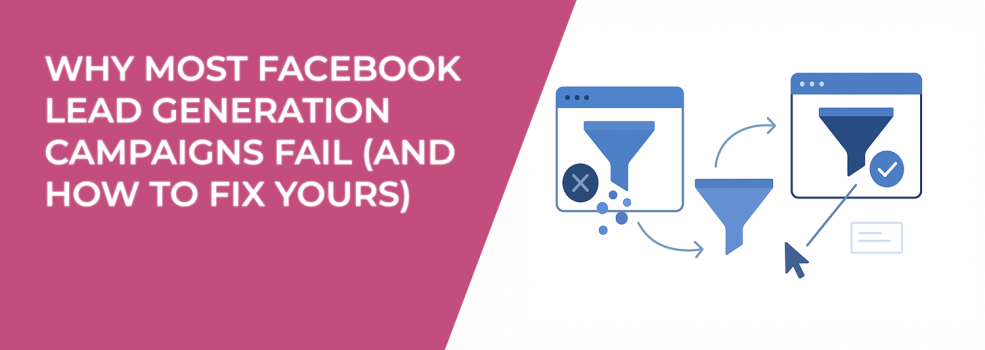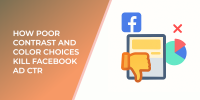Running Facebook lead generation ads is appealing because it seems fast and easy. You set a budget, launch a campaign, and expect a steady flow of leads. But in practice, many advertisers discover that the leads they collect don’t convert into paying customers.
The issue isn’t just Facebook’s system. The real problem comes from how campaigns are planned, built, and followed through. Let’s look at why so many of them fall short — and how you can adjust yours to get better results.
Targeting Problems That Waste Budget
The most common mistake in Facebook lead generation campaigns is poor targeting. Many advertisers rely on broad audiences like “marketing,” “fitness,” or “entrepreneurship” and assume that’s enough. But those categories are too general, and they attract people who have little chance of becoming customers.
A better approach is to target people based on actions and intent. For example:
-
Layer your targeting. Don’t just pick one broad interest. If you sell HR software, combine “HR Managers” with “business page admins” to narrow down to decision-makers.
-
Use engagement audiences. Retarget people who watched half of your video ads or interacted with your Facebook page in the last 90 days. They already know your brand, which makes them more likely to respond.
-
Exclude people who aren’t a fit. If you sell premium services, filter out users who have only signed up for free trials in the past without converting.
For a deeper breakdown of how to do this, check out Facebook Ad Targeting 101: How to Reach the Right Audience.
When you refine your targeting like this, you may collect fewer leads, but the ones you do get are more valuable. Instead of chasing numbers, you’ll get contacts who are closer to becoming customers.
Why Creatives Decide Who Clicks
Targeting decides who sees your ad, but creative decides who clicks. Too many campaigns use bland stock images and vague headlines. The result? People scroll past without caring.
Improving your creatives doesn’t mean spending weeks on design. It means matching your ad to your audience’s stage in the buying process. A few good practices include:
-
Adapt your message to the funnel stage. For cold audiences, use attention-grabbing angles like “See how 200 companies cut costs with this tool.” For warm audiences, show stronger offers like “Get a free personalized audit.”
-
Experiment with formats. Carousels are great for showing different benefits. Short videos often drive more engagement than still images.
-
Show proof. Instead of promises, display real outcomes — a testimonial, a short review, or a quick graph showing results.
If your ads look good but still underperform, Facebook Ads Not Converting: How to Fix It explains how to diagnose the real issue.
Most Facebook traffic is mobile. Always check how your ad looks on a phone screen before publishing. Small layout issues can quietly kill performance.
Instant Forms and Landing Pages: Choosing the Right Tool
Facebook’s instant forms are convenient because they autofill user details. The problem is that this convenience lowers commitment. Many people submit forms without much thought, leaving you with weak leads.
That doesn’t mean you should avoid instant forms altogether. The key is matching the form to your offer:
-
Use instant forms for lighter offers such as a newsletter signup or a free checklist.
-
Use landing pages for higher-value actions like product demos, consultations, or service trials.
Adding extra questions can also help. For example, a B2B company could ask, “What’s your team size?” or “Do you already use a CRM?” These questions filter out casual sign-ups and help your sales team focus on real opportunities.
If you’re debating which route to take, Using Lead Forms vs. Landing Pages: What Works Better? gives a clear side-by-side comparison.
By thinking about intent, not just convenience, you’ll get leads who are more likely to take the next step.
Follow-Up Speed and Quality
Even well-run campaigns fail if leads aren’t followed up quickly. A name in a spreadsheet doesn’t become a sale on its own. Response time is critical, and many advertisers wait far too long.
To improve follow-up, try these steps:
-
Automate first contact. Send a confirmation email or SMS immediately after someone signs up. This keeps them engaged while they’re still thinking about your offer.
-
Route leads to the right person. Use CRM integrations to notify your sales team as soon as a new lead comes in.
-
Prioritize leads. If your form collected data like budget or timeline, score leads and follow up with the strongest ones first.
A lead that hears from you within minutes is far more likely to convert than one who waits two days for a reply. Fast, relevant communication turns ads into real results.
Campaigns That Skip the Funnel
Another reason Facebook lead generation ads fail is that many businesses go straight for the sign-up. Most people don’t give out their contact information to a brand they’ve never seen before. Skipping the funnel means you’re asking for trust too soon.
Instead, think in steps:
-
Start with awareness ads. Share useful content or short videos that explain a problem your product solves.
-
Move to engagement. Retarget people who watched your video or clicked on your content with a more specific offer, like a free guide.
-
End with conversion ads. Once someone knows your brand, show them a lead ad for a demo, consultation, or purchase.
If you’re building out your funnel from scratch, the Facebook Ads Funnel Strategy: From Audience Identification to Conversion is a helpful guide.
This approach takes longer, but it raises the quality of your leads. A skincare brand, for example, might first run a video about common skin concerns, then follow up with a free skin-type quiz, and finally push a product sample offer.
Putting It All Together
If your Facebook lead generation campaigns aren’t working, don’t assume the platform is broken. Look at the pieces:
-
Are you targeting based on real intent, or just broad interests?
-
Do your creatives stand out on mobile feeds?
-
Are you using forms and landing pages in the right way?
-
How fast is your follow-up?
-
Are you moving people through a funnel, or asking for leads too soon?
Answering these questions gives you a clear roadmap for fixing your campaigns.
Final Word
Facebook can absolutely generate high-quality leads — but only if you treat it as more than a quick lead machine. Strong targeting, engaging creatives, smart use of forms, fast follow-up, and funnel thinking make the difference between wasted budget and a reliable pipeline.
If you’re still unsure where to start, How to Define a Target Audience for Marketing: a Step-by-Step Guide can help you structure your first step toward better results.
So, before you launch your next campaign, ask: am I building a system that delivers customers, or just running ads for numbers? The first option takes more thought, but it’s the one that pays off.

